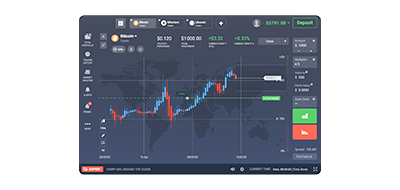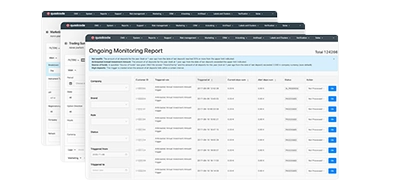Back

Brokerage Business
How To Start a Crypto Broker from Scratch?

Written by:
Vitaly Makarenko
read
Published:
March 15, 2024Updated:
May 3, 2024views
Table of contents
The advent of digital currency has significantly reshaped the financial landscape, presenting new opportunities and challenges. Crypto brokerage, a crucial component in the digital ecosystem, is gaining prominence as cryptocurrencies become increasingly mainstream. This article aims to provide a detailed guide for aspiring entrepreneurs on establishing a crypto brokerage, emphasizing the importance of compliance, technology, risk management, and customer-centricity.
Understanding the Crypto Brokerage Landscape
In the rapidly evolving sphere of digital currencies, crypto brokers stand out as essential intermediaries, smoothing the pathway for transactions involving the acquisition and liquidation of cryptocurrencies. Their role is distinct, offering a suite of services that are more personalized and user-centric compared to traditional cryptocurrency exchanges and trading platforms.
Brokers vs. Exchanges vs. Trading Platforms
Understanding the nuanced differences between brokers, exchanges, and trading platforms is crucial.
- Cryptocurrency Exchanges serve as bustling digital marketplaces, orchestrating direct interactions between buyers and sellers, and acting as the arena where multiple cryptocurrencies are listed and negotiated.
- Trading Platforms are refined software solutions linking buyers to sellers, armed with a suite of tools and resources enabling traders to dissect the market, execute trades, and orchestrate their portfolios meticulously.
- Crypto Brokers are intermediaries that facilitate trades between buyers and sellers. Unlike exchanges, they don’t provide a platform for direct interactions between trading parties. Instead, they offer a more streamlined and simplified trading process, often catering to those who prefer not to navigate the intricacies of a full-fledged exchange.
This discernment is foundational for potential crypto brokers. It illuminates the path in shaping unique service propositions, devising robust operational models, and crafting engaging customer strategies. Understanding these distinctions is instrumental in sculpting business strategies that are aligned with the desires and needs of their clients, ensuring the delivery of services that are competitive, customized, compliant, and stand out in the crowded marketplace, ultimately elevating the overall trading experience and cultivating customer loyalty and business augmentation.
1. Regulatory Compliance and Licensing
For anyone aspiring to operate within the crypto brokerage space, strict adherence to prevailing regulations is non-negotiable, ensuring the legality and integrity of all transactions within the platform. Different jurisdictions have a varying array of laws, but they predominantly revolve around Anti-Money Laundering (AML) and Combating the Financing of Terrorism (CFT). These regulatory frameworks are designed to prevent illicit financial activities, protect consumers, and maintain the integrity of the financial system.
Comprehension and adherence to these regulations are not merely legal necessities but are instrumental in establishing a credible and transparent brokerage service. They act as safeguards, ensuring that the business operates within the legal parameters, thereby enhancing its reputation and fostering a sense of security and trust among the clients. It is vital for brokers to stay abreast of the evolving regulatory landscape to mitigate risks associated with non-compliance, such as severe penalties and reputational damage.
Obtaining Licenses
Obtaining the requisite licenses is a crucial step in establishing a crypto brokerage. This often rigorous and meticulous process is pivotal in affirming the brokerage’s legitimacy and ensures alignment with both local and international financial laws. The process generally involves submitting detailed business plans, operational models, risk management strategies, and compliance frameworks to the relevant regulatory bodies. Each jurisdiction will have its specific requirements, and it is imperative for brokers to thoroughly research and comply with these to obtain the licenses needed to operate legally and successfully.
Compliance Program Components
Developing an all-encompassing compliance program is crucial in maintaining the brokerage’s ethical and operational standards. This program must integrate detailed customer due diligence to verify the identity of clients and assess their risk profiles accurately. This is essential in building a transparent, accountable relationship between the broker and the client, preventing associations with illicit activities or entities.
Transaction monitoring is another vital component, requiring the continuous observation of clients’ transaction patterns and behaviors. This enables the broker to detect and respond to unusual or suspicious activities promptly, mitigating risks associated with fraud, money laundering, or other financial crimes. Sophisticated monitoring tools and technologies are indispensable for effectively identifying, assessing, and managing these risks in real time, ensuring a secure trading environment.
Regular audits are pivotal for evaluating the effectiveness of the compliance program and identifying areas for improvement. These audits scrutinize the brokerage’s adherence to regulatory requirements and internal policies, ensuring that any deviations or inconsistencies are addressed immediately. By conducting audits, the brokerage can enhance its operational efficiency, rectify shortcomings, and fortify its compliance framework against emerging threats and vulnerabilities.
In essence, a well-structured compliance program acts as the brokerage’s safeguard against legal repercussions and reputational damage. Such a program must be dynamic and responsive, evolving in tandem with regulatory advancements and market changes to maintain its relevance and efficacy.
2. Developing a Business Plan
Establishing clear and focused business objectives and goals is fundamental for building a successful crypto brokerage. It’s vital to clearly define the objectives, detailing the mission and vision that will guide the organizational actions and choices. Recognizing the target market is crucial, allowing the creation of customized services and strategies to meet the distinct needs and preferences of the prospective clientele, ensuring the relevance and attractiveness of the brokerage.
Additionally, outlining the services to be provided gives a clear picture of what the brokerage stands for, showcasing the unique aspects that set it apart from the competition. Developing detailed growth strategies provides a clear and actionable pathway that leads the brokerage to ongoing success and expansion, enhancing its market standing and revenue.
Operational Structures
Constructing well-defined operational structures is crucial for orchestrating the seamless and effective execution of brokerage services. This involves the strategic allocation of roles and responsibilities across management, customer service, and technical support teams, optimizing the organizational workflow and enhancing the coordination and responsiveness of the services provided.
A robust management structure is fundamental for driving the brokerage’s strategic direction, decision-making, and overall performance, ensuring alignment with the business objectives and goals. Efficient customer service is essential for fostering positive client relationships, addressing inquiries, and resolving issues promptly, enhancing client satisfaction and loyalty. In contrast, proficient technical support guarantees the smooth operation and reliability of the trading platforms and technological infrastructure, mitigating disruptions and ensuring optimal user experience.
Financial Projections
Accurate identification of funding requirements and the meticulous establishment of realistic financial projections are paramount. They act as a compass for navigating the financial aspects of the brokerage, aiding in securing investments and ensuring the brokerage’s financial sustainability. A thorough financial analysis, encompassing revenue streams, expense forecasts, cash flow projections, and break-even analysis, provides insights into the brokerage’s economic viability and financial health.
Creating sound financial models and projections aids in attracting investors by demonstrating the brokerage’s profitability potential and financial prudence. This is critical in securing the necessary capital to fund the brokerage’s operations, development, and expansion endeavors. Continuous monitoring and adjustment of financial projections in response to market dynamics and organizational developments ensure their accuracy and relevance, supporting informed financial planning and management, and mitigating financial risks.
3. Choosing the Right Technology
In the world of crypto brokerage, technology acts as the pivotal core, the backbone that ensures the brokerage can function and thrive. The strategic integration of suitable technology is imperative. It provides the necessary structure to facilitate seamless and secure transactions and enhances the user experience, creating an environment that is not only user-friendly but also robust in its security and operational capabilities. The careful selection of technology is instrumental in elevating the brokerage’s reliability and credibility, establishing a solid reputation in the competitive crypto market.
Trading Platforms and Software Solutions
Choosing the right trading platform is paramount. The platform must be intuitive and reliable, catering to the varied needs of traders, from novices to seasoned professionals. It should offer dynamic trading experiences, real-time data, advanced charting tools, and swift execution of trades, ensuring users can make informed and timely trading decisions.
Beyond a stellar trading platform, the integration of robust and efficient software solutions significantly impacts the brokerage’s operational efficacy. Implementing advanced Customer Relationship Management (CRM) systems is vital for managing client interactions, personalizing customer experiences, and optimizing business processes, ensuring customers feel valued and supported.
Secure and versatile payment gateways are essential components, enhancing the smoothness and security of financial transactions and reinforcing clients’ trust in the brokerage’s financial integrity. Such integrations are crucial in building and maintaining customer trust and satisfaction, as they assure clients of the reliability and security of their funds and personal information.
Both the trading platform and software solutions need to work cohesively to streamline operations, automate routine tasks, and ensure the secure, seamless flow of data and funds. They are the silent architects of the brokerage’s operational efficiency and security, underpinning its overall success and reliability.
4. Branding and Marketing
A robust brand identity is more than just a logo or a tagline; it’s an amalgamation of the values, missions, and visions that your brokerage stands for. It’s the essence that differentiates your firm in a saturated market, creating a lasting imprint in the minds of potential clients. Establishing a clear, strong brand identity fosters customer loyalty, fortifies market presence, and can be a linchpin in the overall success of the brokerage.
Crafting a Unique Selling Proposition
Your Unique Selling Proposition (USP) is the keystone of your branding strategy. It’s the distinctive advantage, the unique attribute or benefit, that sets your brokerage apart from the competition. Whether it’s superior customer service, innovative trading solutions, or enhanced security measures, a well-articulated USP resonates with your target audience and creates a compelling reason for clients to choose your services over others. A strong USP not only fosters customer loyalty but also augments your brokerage’s market presence, positioning it as a go-to choice in the competitive landscape.
Developing a Comprehensive Marketing Strategy
Formulating and executing an astute, multifaceted marketing strategy is paramount to the brokerage’s growth. A synergistic approach, combining SEO, content marketing, social media, and paid advertising, maximizes visibility and draws in a diverse clientele. SEO and content marketing enhance organic reach, providing value and establishing authority in the niche. Concurrently, social media fosters community engagement and brand advocacy, while paid advertising offers precision targeting and immediate visibility.
- SEO Optimization: It’s crucial to optimize your online content so that a search engine likes to show it as a top result for searches of certain keywords. It improves online visibility and is a critical component of inbound marketing strategy.
- Content Marketing: Regularly publishing valuable and relevant content establishes your brand as an authority in the crypto brokerage space and attracts, informs, and engages your target audience while promoting brand loyalty.
- Social Media Engagement: Active engagement on social media platforms is not just about promotion but about creating a community around your brand, fostering dialogue, and building relationships with your audience.
- Paid Advertising: This can provide an immediate boost in visibility and drive traffic and conversions through targeted campaigns, complementing organic growth strategies.
Measuring Marketing Efficacy
Continuous monitoring and analysis of marketing strategies are crucial to assess their effectiveness and ROI. Using analytics tools to track engagement, conversions, and other relevant metrics, helps in refining marketing approaches and reallocating resources to the most productive channels, ensuring sustained growth and customer acquisition.
5. Website and Mobile Application Development
The development of user-centric platforms is the linchpin for establishing a notable online presence in the crypto brokerage sector. The website and mobile applications serve as the portals through which prospective clients interact with the brokerage, and therefore, they should be developed with a keen focus on user needs and preferences. They should feature intuitive navigation, streamlined design, and robust functionality, all aimed at facilitating user engagement and satisfaction. A well-structured, aesthetically pleasing, and user-friendly interface reflects the brokerage’s professionalism and commitment to quality service.
A secure online environment is paramount, and it involves the incorporation of advanced security protocols, encryption techniques, and regular security audits to safeguard user data and financial transactions. Implementing rigorous security measures is not just about protecting assets; it is about building and maintaining the trust of clients, which is a priceless commodity in the financial sector.
Accessibility is another crucial aspect of online platform development. The platforms should be accessible from various devices and browsers, ensuring that users can execute trades and access services seamlessly, regardless of the device they use. Responsive design adapts the layout to the viewing environment, enhancing the user experience and ensuring the consistent presentation of content across devices. High-level accessibility and responsiveness are not mere conveniences; they are necessities in today’s fast-paced, mobile-centric world, where clients demand instantaneous access to trading platforms and services on the go.
Importance of Seamless User Experience
A smooth, seamless user experience is integral to retaining clients and maintaining a positive brand image. It involves the optimization of every interaction point between the brokerage and the clients, from account creation to trade execution. It requires meticulous attention to detail, continuous user feedback, and iterative improvements to eradicate friction points and enhance user satisfaction. When clients find the platforms easy to use, secure, and accessible, it not only augments user engagement but also fortifies the brokerage’s credibility and reputation in the competitive market.
Conclusion
Starting a crypto broker from scratch is a comprehensive endeavor requiring meticulous planning, unwavering commitment, and extensive knowledge of the financial landscape. By understanding the crypto brokerage landscape, adhering to regulations, developing a robust business plan, choosing the right technology, managing risks effectively, building a strong brand, and ensuring a seamless online presence, aspiring brokers can navigate the complexities of the crypto world and establish successful brokerages.





